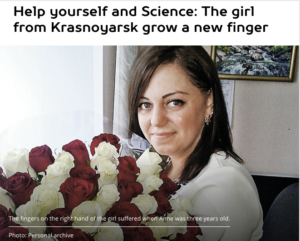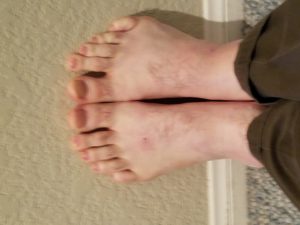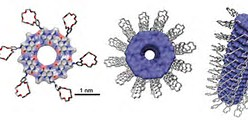 Most of the time we don’t get any useful messages or emails. Only very occasionally do we get something that is actually worth reporting. Here is something.
Most of the time we don’t get any useful messages or emails. Only very occasionally do we get something that is actually worth reporting. Here is something.
The original source was from – http://www.kp.ru/daily/26526.3/3544077/ – From google translator, converting from russian to english, a young russian female by the name of Anna Tsitsyankou of Krasnoyarsk (25 years old). Anna’s mother, Olga, says that her daughter’s middle finger is shorter than the others, relatively from some injury when she was just 3 years old which damaged the growth plate cartilage area in her right middle finger bone.
Using the automatic translator, we get “...Teplyashin” preparing to conduct a unique experiment – to grow its own bone to lengthen the phalanx person who, for whatever reasons, this is not the phalanx.” Further “…scientists will grow on the basis of collected stem cells from her piece of the missing finger bone and then transplanted it to her piece”
So when I read this part, what I am assuming is that the Teplyashin’s team, or any tissue engineering research team, is trying to cut off a piece of anna’s bone, so that they can extract the stem cells in that bone, and use it to turn into a new bone piece. However, it is obvious that it would not be possible, without anna losing even more length of her finger bone for that. Here is how his research team has got around that.
The next paragraph – “A team of scientists of our Center of cellular technologies developed and patented in the US” and the European Union a unique method: 28 days mineral harvesting in vitro in a special solution is saturated with stem cells, and then the surgeon implanting it in the rest of the patient’s native finger. Grown phalanx survives, and no one even noticed after three months, that it in this place once was not!
My interpretation of this following paragraph is that in the lab, a scaffold was created, and anna’s stem cells were extracted and placed into the scaffold where they multiplied for almost a month. After that time, the stem cells completely invaded the structure of the scaffold. Once that was done, somehow the surgeon attached that scaffold to her finger. The surgery was a success and after 3 months, she has a new right middle finger, and the casual person walking by would not notice at all that her right middle finger was unusual at all.
What I am not sure of is whether Teplyashin’s team choose to first cut Anna’s phalanx somewhere in the middle, and attach that scaffold where the cut was, or whether they just attached that scaffold to the finger tip her most distal phalanges bone. However, this story does show that Teplyashin’s team is still working with tissue engineering and regenerative medicine.
The way that this news article explains it, it suggests that the surgical idea was to implant the scaffold which is saturated with stem cells somewhere in the middle of Anna’s phalanges bones. If that is the case, since the article says that the experiment has already been tried, tested, and been successful on lab animals for years (I am assuming they are talking about the old sheep leg experiment which we reported on years ago), maybe we can assume that the Finger growth technique that was patented was not just to attach a lab grown organic piece to the end tip of a finger.
The good news is that this surgery will not cost the girl any money, and the surgery’s cost will be paid for by the researchers. However, she will be responsible for paying for the flight to get to their surgery clinic and her hotel. The article mentioned trying to get Anna 100,000 rubles, which converts to about $1,614 USD to fly her to the surgery clinic.
It would be the news source or website “Komsomolskaya Pravda” which will be reporting on the updates of this story. If you guys want to donate some money for this finger bone lengthening surgery to take place for the russian young woman, then you can contact the following. aveligzhanina@yandex.ru


